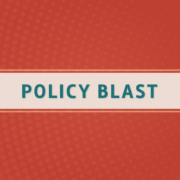House Passes Fiscal Year 2023 Appropriations Minibus with $200 million for Urban Indian Health
On July 21, 2022, the House passed H.R. 8294, a package of six fiscal year (FY) 2023 federal funding bills, by a 220 to 207 vote. Included within the package is the FY 2023 Interior, Environment, and Related Agencies Appropriations bill, which includes $8.1 billion for the Indian Health Service (IHS) and $200 million for urban Indian health, but fails to include advance appropriations for IHS.
- Full text of H.R. 8294
- Bill Report with Urban Indian Health Line Item
- Appropriations Committee Press Release
- NCUIH Policy Alert: House Releases FY 2023 Appropriations Bill with $200 Million for Urban Indian Health, Fails to Include Advance Appropriations (June, 28, 2022)
Background
On June 28, 2022, the House Appropriations Subcommittee on Interior, Environment, and Related Agencies released the Committee Bill Report for the FY 2023 budget with $200 million for urban Indian health. The report and bill were considered by the full House Appropriations Committee on June 29, 2022, after being approved by the House Subcommittee on Interior on June 21, 2022. The bill authorizes $8.1 billion for IHS— an increase of $1.5 billion from FY22 but $1 billion below the President’s budget request. Despite robust advocacy from Tribes and Urban Indian Organizations (UIOs), the bill does not include advance appropriations for IHS. Other key provisions include $17 million for generators for IHS/Tribal Health Programs/UIOs and $3 million for a Produce Prescription Pilot Program for Tribes and UIOs to increase access to produce and other traditional foods. A more detailed analysis follows below.
The President’s budget proposed to shift IHS from discretionary funding to mandatory funding in FY 2023. In the meantime, Native health advocates requested Advance Appropriations until mandatory funding is implemented. To much disappointment, the House bill does not provide (or even mention) advance appropriations for IHS. Advance appropriations is a long-standing priority for Indian Country and advocates have been requesting Congress to provide stable funding for IHS, especially considering the COVID-19 pandemic which has had tremendous, adverse impacts on American Indians and Alaska Natives. In the past month alone, NCUIH sent a letter to request Speaker Pelosi and Minority Leader McCarthy to allow for advance appropriations, and NCAI and NIHB also sent an action alert to request the Appropriations Committee include advance appropriations. Previously, NCUIH, along with 28 Representatives and 12 Senators requested advanced appropriations for IHS until such time that authorizers move IHS to mandatory spending.
Status of Senate Interior Appropriations Bill
The Senate has yet to release their appropriations bills, and it is unlikely they will pass their bills before the current September 30 deadline. Congress will need to rely on a Continuing Resolution to avoid a government shutdown.
Bill Highlights
Indian Health Service: $8.1 billion
- $8.1 billion for the Indian Health Service, an increase of $1.5 billion above the FY 2022 enacted level.
Urban Indian Health: $200 million
- Bill Report: “The recommendation includes $200,000,000 for Urban Indian Health, $126,576,000 above the enacted level and $200,000,000 above the budget request. This amount includes $31,000 transferred from the Alcohol and Substance Abuse Program as part of the for NIAAA program. The Committee expects the Service to continue including current services estimates for Urban Indian health in annual budget requests.”
Mandatory Funding:
- Bill Report: “For fiscal year 2023, the Administration proposed reclassifying IHS accounts as mandatory and did not submit a discretionary budget proposal. However, IHS did not provide implementation language and at the time of writing this report, the authorizing committees have not enacted the President’s proposal. Because the authorizing committees have not acted, the Committee is providing discretionary funds for IHS for fiscal year 2023 to ensure health care for Native Americans is not negatively impacted.”
- Note: There is no mention of advance appropriations for IHS in this bill.
Equipment: $118.5 million
- Bill Report: “The recommendation includes $118,511,000 for Equipment, $88,047,000 above the enacted level and $118,511,000 above the budget request. The bill continues $500,000 for TRANSAM.
- The report further states: “The Committee is aware that the increasing severity and frequency of extreme weather events has motivated certain jurisdictions to adopt de-energization protocols to reduce the risks of catastrophic wildfires. While these protocols are useful in limiting loss of life in affected communities, they can also have dire consequences for Tribal Health Programs located in impacted areas. To increase the resilience of these facilities, the recommendation includes an additional $17,000,000 to purchase generators for IHS, Tribal Health Programs, and Urban Indian Organizations located in areas impacted by de-energization events. In procuring backup generators, the Indian Health Service is directed to determine the most cost-effective method, which may include leasing. In determining the most cost-effective procurement method, the Service shall account for life-cycle maintenance costs associated with direct ownership and clinics’ capabilities to maintain these generators.”
Electronic Health Records: $284.5 million
- Bill Report: “To improve the current IT infrastructure system to support deployment of a new modern electronic health records (EHR) solution, the recommendation includes $284,500,000 for Electronic Health Records, $139,481,000 above the enacted level and $284,500,000 above the budget request.
- The report further states: “The Committee urges IHS to continue moving forward with modernizing its aging EHR system by replacing it with a solution that is interoperable with the new EHR at the Department of Veterans Affairs and with systems purchased by Tribes and UIOs. Modernization should include robust Tribal consultation and planning to ensure that Tribes and UIOs are enabled to take full advantage of resulting modern health information technology and are not unduly burdened during this process.”
Mental Health: $130 million
- Bill Report: “The recommendation includes $129,960,000 for Mental Health, $8,014,000 above the enacted level and $129,960,000 above the budget request.”
Alcohol and Substance Abuse: $264 million
- Bill Report: “The Committee provides $264,032,000 for Alcohol and Substance Abuse, $5,689,000 above the enacted level and $264,032,000 above the budget request. This amount transfers $31,000 to Urban Indians from the former National Institute on Alcohol Abuse and Alcoholism (NIAAA). Funding for Substance Abuse and Suicide Prevention grants is continued at fiscal year 2022 enacted levels.”
Community Health Aide Program (CHAP): $25 million
- Bill Report: “[…] an additional $20,000,000 is provided to expand the Community Health Aide Program to the lower 48 states with direction for IHS to report within 90 days of enactment of this Act on how funds will be distributed”
Tribal Epidemiology Centers: $34,433,361
- Bill Report: “[…] an additional $10,000,000 is for Tribal Epidemiology Centers”
Hepatitis C, HIV/AIDS and STDs Initiative: $52 million
- Bill Report: “[…] an additional $47,000,000 is for the Hepatitis C, HIV/AIDS and STDs initiative.”
Maternal Health: $10 million
- Bill Report: “The recommendation also includes an additional $4,000,000 to improve maternal health with continued direction to report to the Committee within 180 days of enactment of this Act on use of funds, updates on staff hiring, status of related standards, and the amount of training provided with these funds.”
Alzheimer’s Disease: $5.5 million
- Bill Report: “The recommendation maintains $5,500,000 to continue Alzheimer’s and related dementia activities at IHS. These funds will further efforts on Alzheimer’s awareness campaigns tailored for the AI/AN perspective to increase recognition of early signs of Alzheimer’s and other dementias; quarterly, competency-based training curriculum, either in-person or virtually, for primary care practitioners to ensure a core competency on assessing, diagnosing, and managing individuals with Alzheimer’s and other dementias; pilot programs to increase early detection and accurate diagnosis, including evidence based caregiver services within Indian Country, inclusive of urban Indian organizations (UIO); and an annual report to the Committee with data elements including the prevalence of Alzheimer’s incidence in the preceding year, and access to services within 90 days of the end of each fiscal year. The Committee continues direction to develop a plan, in consultation with Indian Tribes and urban confer with UIOs, to assist those with Alzheimer’s, the additional services required, and the costs associated with increasing Alzheimer’s patients and submit this information to Congress within 270 days of enactment of this Act.”
Produce Prescription Pilot Program:
- Bill Report: “The Committee continues $3,000,000 for IHS to create, in coordination with Tribes and UIOs, a pilot program to implement a produce prescription model to increase access to produce and other traditional foods among its service population. Within 60 days of enactment of this Act, the Committee expects IHS to explain how the funds are to be distributed and the metrics to be used to measure success of the pilot, which shall include engagement metrics, and may include appropriate health outcomes metrics, if feasible.”
Headache Disorders Centers of Excellence:
- Bill Report: “The Committee recognizes that over 560,000 people under IHS care are living with migraine or severe headache disorders and that AI/AN communities have the highest prevalence of both disabling headache disorders and concussion/mild traumatic brain injuries, among any racial or ethnic group in the United States. The Committee is concerned that AI/AN patients with chronic migraine, post-traumatic headache, and other disabling headache disorders often do not receive necessary specialty care. The IHS is encouraged to consider the feasibility of IHS Headache Centers of Excellence and if feasible, developing a budget proposal to establish IHS Headache Centers of Excellence to provide direct care, telehealth, and consultation patient services, as well as education and training.”







Leave a Reply
Want to join the discussion?Feel free to contribute!